
Area-wide pest management targets the pest population of an entire area rather than a single farm. Such collective efforts are more efficient in the use of pest-control inputs and therefore have more lasting effects relative to individual (uncoordinated) farm sprays when pest populations are highly mobile. Coordinated sprays may also help reduce pesticide resistance (Vreysen, Robinson, and Hendrichs, 2007). From an economic standpoint, growers are expected to join an area-wide management group and coordinate pest management practices whenever the benefits outweigh the costs.
Remarkably, Florida citrus growers’ participation in area-wide pest management has not been commensurate with evidence regarding its effectiveness in dealing with citrus greening. A likely explanation for the low participation rate is that the cost of coordinating insecticide sprays includes more than just application costs; it also includes the uncertainty growers face regarding their neighbors’ behavior.
Citrus greening, or Huanglongbing (HLB), is a bacterial disease spread by the Asian citrus psyllid. It is considered to be the most devastating citrus disease worldwide (FAO, 2015). It is still not clear how the disease works because scientists have not been able to cultivate the bacteria in the lab (Parker et al., 2014), so no treatment or management strategy is yet available for growers to cure the disease in the field. In Florida, the largest citrus-producing state in the United States, orange production has decreased by 70% since HLB was found in 2005 (USDA, 2016), and the disease is now endemic. Hodges et al. (2014) estimate that HLB caused $7.80 billion in economic losses between 2006/07 and 2013/14.
The disease and the psyllid present a complex problem to growers. The symptoms of HLB are first seen in the canopy of the tree and, eventually, the fruit is affected as well (Halbert and Manjunath, 2004; Bové, 2006). However, Johnson et al. (2014) find that roots are infected prior to the tree canopy showing any symptoms. After the initial infection, it can take 6 to 12 months before the first symptoms become visible (Bové, 2006). Hence, the spread and impact of the disease occur over multiple years. The conventional protocol for managing HLB consists of inspecting trees for symptoms and controlling the pysllid by means of insecticide sprays. If symptoms are found on a tree, removing that tree is recommended to ensure the elimination of the bacteria (Bové, 2006).
From an economic perspective, the latency period—which prevents growers from removing all sources of bacteria from their groves—and the recommendation from plant pathologists to eradicate symptomatic trees is problematic because trees are still productive during the early infection stage. Thus, growers must choose between future and current economic profit. In Florida, a significant proportion of growers were reluctant to remove symptomatic trees and opted instead to use foliar nutritional programs to try to maintain the health and productivity of infected trees (Gottwald et al., 2012).
The dilemma on future versus current profits is further compounded because the effectiveness of individual, uncoordinated pest control treatments is compromised by the mobility of pests (Vreysen, Robinson, and Hendrichs, 2007). Since insect pests can move freely across farms, they can therefore be viewed as common property (Lazarus and Dixon, 1984). Thus, crop damage depends not only on the individual farm pest population but also on the total regional pest population.
Multiple studies examine the dispersal distance of the psyllid (Aubert, 1990; Arakawa and Miyamoto, 2007; Boina et al., 2009; Halbert et al., 2010; Hall and Hentz, 2011; Kobori et al., 2011). Some of these studies provide evidence that the psyllid can disperse widely and also be dispersed by movement of trailers of unprocessed fruit. Lewis-Rosenblum et al. (2015) find that the psyllid is capable of traveling 2 kilometers over a period of 12 days, calling for an area-wide perspective in pest control. Therefore, the ability of individual farmers to control the disease vector also depends on the actions of neighboring growers.
By coordinating pest control, growers may internalize externalities—defined in our case as the impact of a grower’s pest control choices on other growers, without pecuniary remuneration—and increase the productivity of pest-control inputs. Miranowski and Carlson (1986) point out that collective pest control may result in a higher level of welfare relative to individual optimization. However, area-wide pest management programs are not without challenges. Despite the desirable technical, economic, and environmental outcomes of area-wide pest management, the implementation of such programs can encounter resistance due to concerns over methods, free riding, general public opposition, and lack of stakeholder participation, among other issues (Klassen, 2000; Mumford, 2000).
To realize the potential benefits associated with area-wide pest management, all (or at least a majority) of growers may need to participate in the program. If a significant number of growers in an area fail to coordinate, the resulting pest control would be lower compared to the efficient outcome, and a higher pest population should be observed in that area. We analyze data on two areas with different levels of participation and address whether, and to what extent, partial participation is effective.
Florida’s main competitor in orange-juice production is Brazil, where HLB was found in 2004 (Colleta-Filho, 2004; Bové, 2006). To date, the magnitude of the impact of HLB in Brazil has been less dramatic than in Florida, mainly because Brazilian growers adopted tree eradication at the beginning of the outbreak to ensure the elimination of the inoculum. Bassanezi et al. (2013) find evidence that combining inoculum removal and sprays for psyllid in Brazil was effective in reducing disease epidemics when performed as part of an area-wide management program. Despite its lower spread relative to Florida, HLB still imposes a significant economic burden on Brazilian producers in terms of costs of scouting for psyllids, tree removal, and insecticide applications (Belasque et al., 2010).
The establishment of an area-wide management program for psyllid control in Florida was part of the strategic plan of the state’s citrus industry to address HLB (National Academy of Sciences, 2010). Thus, Citrus Health Management Areas (CHMAs) were created around 2010 as voluntary groupings of growers to work cooperatively to coordinate insecticide application timing and mode of action to control the spread of psyllids across neighboring commercial citrus groves in Florida.
We analyzed data provided by a grower owning two sets of Valencia orange blocks in two different CHMAs to assess whether there was any significant difference in the yield and profitability attained in the two areas. The two CHMAs were located in neighboring counties in central Florida and had comparable climatic conditions. A key feature of the dataset was that all blocks were managed using the same practices and had similar characteristics, including tree age, tree density, reset plantings, and rootstocks. However, the level of grower participation was substantially different. The grower who provided the data estimated participation in CHMA 2 to be three to five times higher than participation in CHMA 1. Therefore, the differing “treatment” across blocks was the level of participation in the area-wide pest-control management program.
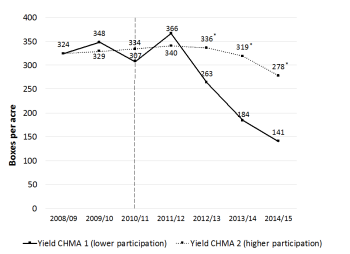
Note: The vertical dashed line denotes CHMAs started
in 2010/11.
*Denotes a statistically significant difference between
the yields in CHMA 1 and 2.
The data on annual yields include production by block for crop years 2008/09 to 2014/15 for six blocks comprising 221 acres in CHMA 1 and for five blocks totaling 161 acres in CHMA 2. Figure 1 shows the average yield per acre for the Valencia orange blocks in each CHMA has been decreasing since 2011/12. Given there were no hurricanes or significant freezes during those years, the reduction in yields is most likely due to the increasing negative impact of HLB on production. These results help explain the findings of Singerman and Useche (2016), who found that, on average, 90% of acres and 80% of trees in a citrus operation in Florida are infected with HLB. They also found that the average percentage yield loss that growers attribute to HLB is 41%.
Figure 1 also illustrates that from 2012/13 to 2014/15, blocks located in CHMA 2—where grower participation was higher relative to CHMA 1—had (statistically) significantly higher yields compared to CHMA 1 (based on regression results of a random effects model, not shown here). This yield gap between the two CHMAs has been increasing over time. These findings provide evidence of the effectiveness of well-performing CHMAs as way to deal with HLB.
Table 1 reports the differential yields and benefits accruing to CHMA 2 over CHMA 1 since the beginning of the CHMA program. To compute the gross differential benefit (column 5), the annual yield differential (column 3) was multiplied by the corresponding price per box for processed Valencias (column 4). To estimate the direct cost of CHMA participation, the program of CHMA 2 was assumed to consist of eight sprays, which in many cases can be applied aerially and cost $8 per acre each for a total of $64 per acre (column 6). The aerial application is done either by helicopter or airplane. Aerial application is cheaper than ground application (on a per acre basis) because it covers an acre in a fraction of the time (and cost) that a tractor does, but it is only justified when spraying large areas. Small individual growers spraying only their groves would not find it cost effective. Another limiting factor is that if the grove is adjacent to a residential area, aerial applications are not allowed.

Source: Prices in column (4) are from USDA-NASS (2016); all other columns are authors’ calculations.
*Denotes a statistically significant difference between the yield in CHMA 2 and that of CHMA 1.
Alternatively, a grower may need to perform eight ground applications, which cost $25 per acre for a stand-alone application (although, to make the application cheaper, a tank mix with other chemicals is typically used instead) for a total of $200 per acre (column 6). We estimated the cost of materials at $18 per acre per application for a total of $144 per acre (column 7). The cumulative net differential benefit is positive and substantial (columns 8 and 9), not only when considering years in which a positive statistically significant differential benefit was observed but also when considering all years since CHMAs started in 2010/11 and assuming no yield differential during the first year. The case for collective action is even stronger because the differential benefits shown in Table 1 were computed assuming zero cost for CHMA 1’s spray program, thus providing further evidence of the efficiency of CHMA 2 to deal with HLB, and enhance the individual growers’ profitability at a time when margins are becoming increasingly narrow.
Our hypothesis is that strategic uncertainty—defined as uncertainty regarding the actions and beliefs of others—plays a key role in undermining CHMA participation. As Morris and Shin (2002, p. 2) put it, “the idea is that even a small seed of doubt concerning the ability of the players to close ranks to achieve the good outcome will start to undermine the resolve of an individual player to stick to the cooperative strategy, and opt out.”
In 2015, there were 55 CHMAs in Florida distributed across 26 counties, but it is estimated that only 19 CHMAs were actively coordinating sprays (CREC, 2016). The lack of state-wide participation in CHMAs is startling given the magnitude of the estimated differential economic benefit, the impact of the disease across the state, and our finding that participation need not be 100% for the program to work well (as shown in the previous section). Also, our results do not support the characterization of CHMAs as a weakest-link public good problem, in which a grower’s success hinges on that of the fellow grower making the least effort.
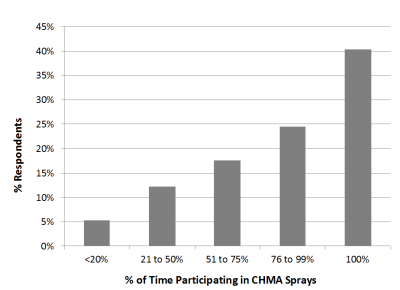
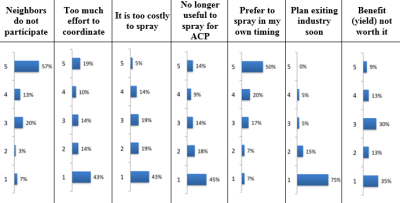
Note: Responses are on a scale from 1 to 5, where 1 is
“Disagree,” 3 is “Somewhat Agree,” and 5 is “Agree.”
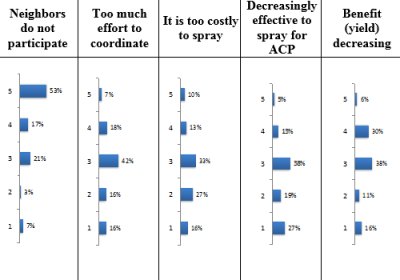
Note: Responses are on a scale from 1 to 5, where 1 is
“Disagree,” 3 is “Somewhat Agree,” and 5 is “Agree.”
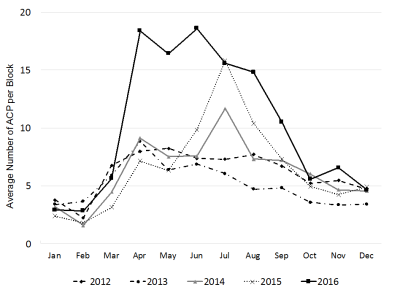
Source: USDA-APHIS-Citrus Health Response Program
(CHRP)-Plant Protection and Quarantine (PPQ).
The communication for coordinating sprays is by email, so the communication cost is given by the time and effort required to coordinate sprays. In addition, the CHMA captains post general comments on the CHMA websites, so there is no coordination organization establishment, and there are no fixed costs associated with communication. Some of the sprays, the dormant sprays, are standard, that is, pre-determined every year. If the psyllid count is relatively high, the CHMA captain/leader will ask growers to coordinate additional sprays on an ad hoc basis.
Given the lack of information about grower participation in CHMAs, we conducted a paper-based survey among Florida citrus growers to learn more about their behavior related to CHMAs and their attitudes toward the area-wide pest management program. The survey took place during an extension meeting organized by the University of Florida in April 2016. A total of 123 growers representing 153,278 acres participated in the survey, representing approximately one-third of the total citrus acreage in Florida. When asked about whether they participate in CHMAs, 37% of the growers stated they do not participate, whereas 63% stated they do. However, only 40% of the latter stated that they participated in coordinated sprays 100% of the time (Figure 2). Thus, the majority of those who participate do so in a limited fashion.
When asked to rate their reasons for not participating in coordinated sprays, 57% of non-participants stated that their top reason was that other growers do not participate (Figure 3). Their responses indicate that their belief about the reluctance of others to participate makes them not participate in CHMAs. The second reason for not participating was “I prefer to spray on my own timing,” with 50% of the non-participants agreeing with such statement. This result denotes the growers’ own reluctance to coordinate efforts. In addition, “too much effort to coordinate” was the reason receiving the third-largest percentage of “agree” responses (19%) from non-CHMA participants.
Figure 4 summarizes the responses from CHMA participants’ beliefs regarding the obstacles to increase CHMAs effectiveness. Like non-participants, CHMA participants stated neighbors not participating as the top obstacle to increase CHMAs effectiveness. Interestingly, other than their agreement on neighbors’ participation, CHMA participants and non-participants diverged in their opinions on the rest of the statements. Thus, overall, it is clear from the survey responses that (lack of) coordination has been a major obstacle for the establishment and correct operation of CHMAs.
In March 2016, the Florida Commissioner of Agriculture declared a citrus crisis, allowing growers across the state to use streptomycin and oxytetracycline as bactericides to attempt to enhance the health of trees infected with HLB (CRDF, 2016). However, the expected enhancement of those compounds on HLB-infected trees is not yet proven. Quite interestingly, psyllid population data suggest that the declaration has had the unintended effect of increasing the psyllid infestation. The average psyllid population in Florida spiked in 2016, achieving an all-time high (Figure 5). This spike occurred shortly after the citrus crisis announcement allowing for the use of bactericides, which suggests that growers are likely substituting insecticide applications with streptomycin and oxytetracycline. This substitution would imply that growers are getting away from the strategic uncertainty posed by CHMAs and choosing instead the risky/uncertain outcome associated with the self-managed strategy of bactericides (which they evidently perceive to be lower).
The basic tenet of allowing for the use of streptomycin and oxytetracycline to manage HLB, that is that they might improve the condition of the trees infected with HLB, requires little coordination among growers. However, if these compounds are eventually found to be ineffective in enhancing the health of HLB-infected trees, encouraging their use now may severely hamper the chances of controlling HLB, not only because of the compounds’ ineffectiveness but also because of their lack of reliance on the coordination required for CHMA success.
This case study provides valuable insights into the usefulness of area-wide pest management. Despite the data limitations, we were able to estimate the magnitude of and extent to which coordinating sprays can mitigate the impact of HLB on yields and compute the associated profit differential. The results are important not only for Florida but also for other citrus-producing regions, such as California, that are starting to be affected by the disease and could implement area-wide pest management earlier and more effectively than Florida. It is highly unlikely that solely improving area-wide spray coordination efforts on groves already showing severe HLB-induced tree decline would change the outlook for those groves. However, given that there is currently no cure, efforts should be made to boost coordination to threshold levels that make cooperation efficient against HLB.
Given that spray coordination was found to be beneficial, why there is so much disparity in CHMAs participation? At first, it is sensible to assume that this is the result of a typical public good problem. But the issue is not free riding on the contribution (spraying) of others. When analyzing the barriers to herbicide-resistant management, Hurley, Mitchell, and Frisvold (2009) pointed out that economic factors are not farmers’ only incentive. As argued by Miranowski (2016, p. 2), “behavioral and socioeconomic factors may challenge rational economic behavior—profit maximizing—on the part of farmers and landowners and these factors may lead to a form of market failure.” Our survey data unveiled a behavioral component related to strategic uncertainty that shed some light on growers’ otherwise seemingly irrational behavior, helping to explain why participation in CHMAs, and therefore their success, is not as widespread across Florida as one might expect.
A more general lesson is that case study data analyses can be illuminating and provide guidance for research. This is particularly true in the case of a new threat, when broader and more comprehensive data are not available and practical answers to problems are pressing. From the results of our study, it is clear that for all pests, or even weeds, that call for area-wide management, further research is needed regarding the factors that influence the strategic behavior of agents in such contexts and how to overcome them.
Another important lesson is the usefulness of learning about the ways in which other regions are dealing with the same problem so that strategies better adapted to local idiosyncrasies can be designed as fast and efficiently as possible. Unlike Florida growers, Brazilian growers not only opted to eradicate infected trees within their groves, but they have also gone beyond the borders of their own operation to protect their crops. Johnson and Bassanezi (2016) report an interesting case study of cooperation for psyllid control in Brazil in which a large (corporate) grower started an psyllid control program beyond his grove borders. Having noticed increasing infection rates on the edges of his groves, the grower offered to spray the trees of neighboring small growers and backyard citrus homeowners—within a 2.5-mile radius of their operations—on a monthly basis. Alternatively, homeowners were offered replacement fruit trees other than citrus. According to the authors, the grower obtained a return of $30 for every dollar spent in the program during the first two years. So, seeking self-interest, the grower coped with issues related to lack of neighbors’ participation due to heterogeneity, lack of incentives, etc. by increasing the level of pest-control inputs of neighbors. In this regard, Vicary and Sandler (2002) found that when costs differ between agents, in-kind transfers from the low-cost agent to the high-cost agent can improve welfare.
The Brazilian grower initiative could perhaps be used as an example or as inspiration for other innovative or multifaceted strategies. However, it is also important to be aware of and understand the differences across the different regions to ensure their applicability and success. Brazil’s citrus industry structure is different from that of Florida. In Brazil there are, on average, larger growers that farm contiguous properties that make dealing with neighbors easier. In addition, many of the smaller growers in Brazil have the possibility of switching to other crops. Finally, cultural differences may also play a role in the success of in-kind transfers in Brazil; landowners in Florida (and the U.S. in general) are likely to be more apprehensive of their property rights.
Arakawa, K., and K. Miyamoto. 2007. “Flight Ability of Asiatic Citrus Psyllid, Diaphorina citri Kuwayama (Homoptera; Psyllidae), Measured by a Flight Mill.” Research Bulletin Plant Protection Service Japan 43:23–26.
Aubert, B. 1990. “Integrated Activities for the Control of Huanglongbing-Greening and Its Vector Diaphorina citri Kuwayama in Asia.” In B. Aubert, S. Tontyaporn & D. Buangsuwon, eds. Rehabilitation of Citrus Industry in the Asia Pacific Region: Proceedings of the Asia Pacific International Conference on Citriculture, February 4–10, Chiang Mai, Thailand. Rome: FAO, pp. 133–144.
Bassanezi, R.B., L.H. Montesino, N. Gimenes-Fernandes, P.T. Yamamoto, T.R. Gottwald, L. Amorim, and A. Bergamin Filho. 2013. “Efficacy of Area-Wide Inoculum Reduction and Vector Control on Temporal Progress of Huanglongbing in Young Sweet Orange Plantings.” Plant Diseases 97:789–796.
Belasque, J., Jr., R.B. Bassanezi, P.T. Yamamoto, A.J. Ayres, A. Tachibana, A.R. Violante, A. Tank, Jr., F. Di Giorgi, F.E.A. Tersi, G.M. Menezes, J. Dragone, R.H. Jank, Jr., and J.M. Bové. 2010. “Lessons from Huanglongbing Management in São Paulo State, Brazil.” Journal of Plant Pathology 92(2):285–302.
Boina, D.R., M.L. Meyer, E.O. Onagbola, and L.L. Stelinski. 2009. “Quantifying Dispersal of Diaphorina citri (Hemiptera: Psyllidae) by Immunomarking and Potential Impact of Unmanaged Groves on Commercial Citrus Management.” Environmental Entomology. 38(4):1250–1258.
Bové, J.M. 2006. “Huanlongbing: A Destructive, Newly-Emerging, Century-Old Disease of Citrus.” Journal of Plant Pathology 88(1):7–37.
Citrus Research and Development Foundation (CRDF). 2016. Crisis Declaration by Commissioner Adam Putnam Allows Use of Bactericides as Foliar Treatments in Florida Citrus. Available online: http://citrusrdf.org/wp-content/uploads/2012/09/HLB-Bactericide-Crisis-Declaration-and-Labels.pdf
Citrus Research and Education Center (CREC), University of Florida. 2016b. Citrus Health Management Areas. Available online: http://www.crec.ifas.ufl.edu/extension/chmas/index.shtml
Colleta-Filho, H.D., M.L.P.N. Tagon, M.A. Takita, J.D. De Negri, J. Pompeu, Jr., and M.A. Machado. 2004. “First Report of the Causal Agent of Huanglongbing (“Candidatus Liberibacter asiaticus”) in Brazil.” Plant Disease 88:1,382.3.
Gottwald, T.R., J.H. Graham, M.S. Irey, T.G. McCollum, and B.W. Wood. 2012. “Inconsequential Effect of Nutritional Treatments on Huanglongbing Control, Fruit Quality, Bacterial Titer and Disease Progress.” Crop Protection 36:73–82.
Halbert, S.E., and K.L. Manjunath. 2004. “Asian Citrus Psyllids (Sternorrhyncha : Psyllidae) and Greening Disease of Citrus: A Literature Review and Assessment of Risk in Florida.” Florida Entomologist 87:330–353.
Halbert, S.E., K.L. Manjunath, C. Ramadugu, M.W. Brodie, S.E.Webb, and R.F. Lee. 2010. “Trailers Transporting Oranges to Processing Plants Move Asian Citrus Psyllids.” Florida Entomologist 93(1):33–38.
Hall, D.G., and M.G. Hentz. 2011. “Seasonal Flight Activity by the Asian Citrus Psyllid in East Central Florida.” Entomologia Experimentalis et Applicata 139:75–85.
Hodges, A.W., M. Rahmani, T.J. Stevens, and T.H. Spreen. 2014. “Economic Impacts of the Florida Citrus Industry in 2012–13.” Gainesville, FL: University of Florida, Food & Resource Economics Department. Available online: http://www.fred.ifas.ufl.edu/pdf/economic-impact-analysis/Economic_Impacts_Florida_Citrus_Industry_2012-13.pdf
Hurley, T.M., P.D., Mitchell, and G.B. Frisvold. 2009. “Weed Management Costs, Weed Best Management Practices, and Roundup Ready Weed Management Program.” AgBioForum 12(384):281–290.
Johnson, E. and R. Bassanezi. 2016. HLB in Brazil: What’s Working and What Florida Can Use. Citrus Industry, June 2016.
Johnson, E.G., J. Wu, D.B. Bright, and J.H. Graham. 2014. “Association of ‘Candidatus Liberibacter asiaticus’ Root Infection, but Not Phloem Plugging with Root Loss on Huanglongbing-Affected Trees Prior to Appearance of Foliar Symptoms.” Plant Pathology 63(2):290–298.
Klassen, W. 2000. “Area-Wide Approaches to Insect Pest Management: History and Lessons.” In K. H. Tan, ed. Proceedings: Area-Wide Control of Fruit Flies and Other Insect Pests. International Conference on Area-Wide Control of Insect Pests, and the 5th International Symposium on Fruit Flies of Economic Importance, 28 May–5 June, Penang, Malaysia. Pulau Pinang, Malaysia: Penerbit Universiti Sains Malaysia, pp. 21–38.
Kobori, Y., T. Nakata, Y. Ohto, and F. Takasu. 2011. “Dispersal of Adult Asian Citrus Psyllid, Diaphorina citri Kuwayama (Homoptera: Psyllidae), the Vector of Citrus Greening Disease, in Artificial Release Experiments.” Applied Entomology Zoology 46:27–30.
Lazarus, W.F., and B.L. Dixon. 1984. “Agricultural Pests as Common Property: Control of the Corn Rootworm.” American Journal of Agricultural Economics 66:456–465.
Lewis-Rosenblum, H., X. Martini, S. Tiwari, and L.L. Stelinki. 2015. “Seasonal Movement Patterns and Long-Range Dispersal of Asian Citrus Psyllid in Florida Citrus.” Journal of Economic Entomology 108:1–8.
Miranowski, J.A. 2016. “Intervention to Manage Pest Resistance: Community-Based or Government Regulation.” Choices 31(4):1–8.
Miranowski, J.A., and G. Carlson. 1986. “Economic Issues in Public and Private Approaches to Preserving Pest Susceptibility.” In Committee on Strategies for the Management of Pesticide Resistance Pest Populations, Pesticide Resistance: Strategies and Tactics for Management. Washington, DC: National Academy Press, pp. 436–448.
Morris, S., and H.S. Shin. 2002. Measuring Strategic Uncertainty. Available online: http://www.nuff.ox.ac.uk/users/Shin/PDF/barcelona.pdf
Mumford, J. 2000. “Economics of Area-Wide Pest Control.” In K. H. Tan, ed. Proceedings: Area-Wide Control of Fruit Flies and Other Insect Pests. International Conference on Area-Wide Control of Insect Pests, and the 5th International Symposium on Fruit Flies of Economic Importance, 28 May–5 June 1998, Penang, Malaysia. Pulau Pinang, Malaysia: Penerbit Universiti Sains Malaysia, pp. 39–47.
National Academy of Sciences. 2010. Strategic Planning for the Florida Citrus Industry: Addressing Citrus Greening Disease. Available online: http://dels.nas.edu/resources/static-assets/materials-based-on-reports/reports-in-brief/citrus_greening_report_brief_final.pdf
Parker J.K., S.R. Wisotsky, E.G. Johnson, F.M. Hijaz, N. Killiny, M.E. Hilf, and L. De La Fuente. 2014. “Viability of 'Candidatus Liberibacter asiaticus' Prolonged by Addition of Citrus Juice to Culture Medium.” Phytopathology 104(1):15–26.
Singerman, A., and P. Useche. 2016. “Impact of Citrus Greening on Citrus Operations in Florida.” Gainesville, FL: University of Florida/IFAS, EDIS document FE 983. Available online: https://edis.ifas.ufl.edu/fe983
U.S. Department of Agriculture (USDA). 2016. Florida Citrus Statistics 2014–2015. Washington, DC: U.S. Department of Agriculture, National Agricultural Statistics Service, February. Available online: https://www.nass.usda.gov/Statistics_by_State/Florida/Publications/Citrus/Citrus_Statistics/2014-15/fcs1415.pdf
Vreysen, M.J.B., A.S. Robinson, and J. Hendrichs. 2007. “Area-Wide Integrated Pest Management (AW-IPM): Principles, Practice and Prospects.” In M.J.B. Vreysen, A.S. Robinson, and J. Hendrichs, eds. Area-Wide Control of Insect Pests: From Research to Field Implementation. Dordrecht: Springer, pp. 3–33.
Link to Published Journal Article: https://doi.org/10.1093/aepp/ppx030